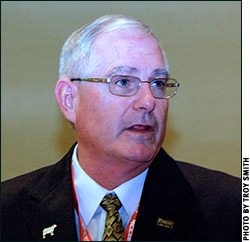Should You Invest in Land or Buildings?
Purdue animal scientist shares considerations for producers considering semi-confinement production.
It really isn’t a new concept. Many cow-calf producers have confined cows to sacrifice pastures or drylots, or under a roof, during a portion of the production year. However, there is new interest in managing breeding herds under total or semi-confinement. Largely due to the high costs associated with purchasing or renting grazing land, some aspiring cattlemen and producers contemplating expansion of their existing operations are considering whether keeping cows in confinement could work for them.

“There is no question that management must intensify with a confinement system,” stated Ron Lemenager, “but I do believe there is opportunity to reduce production costs compared to more conventional production systems.”
At an Angus University Workshop hosted during the 2016 Angus Convention in Indianapolis, Ind., Purdue University animal scientist Ron Lemenager talked about management considerations for managing cows and calves under confinement. He said confinement offers advantages and disadvantages with regard to management of nutrition, environmental conditions and health.
“There is no question that management must intensify with a confinement system,” stated Lemenager, “but I do believe there is opportunity to reduce production costs compared to more conventional production systems. From a feed standpoint, I believe costs could be reduced by as much as 30%.”
Lemenager said producers considering confinement must think about the most advantageous time to calve. When will environmental conditions be most favorable for calving, or for breeding? Based on choice of calving season, when will nutrient requirements for cows be highest? When is labor most needed and when is it most available?
According to Lemenager, dividing the breeding herd into management groups based on differing nutritional needs of heifers, young cows and mature cows can assure that diets meeting the nutrient requirements of each group can be provided.
“Producers need to consider what feedstuffs are available and have feeding equipment. They will have to feed a balanced diet — probably a total mixed ration,” Lemenager added.
Early weaning of calves may be advantageous. The nutrient requirements of their dams would be reduced and calves could be fed to gain faster. Lemenager said time of marketing for calves should be well thought out, as well as marketing of cull cows.
Drylots or pens within a barn must be designed to allow sufficient animal space. Lemenager recommends 90 square feet (sq. ft.) per pair for cows of small mature size. For larger cows — 1,400 pounds or more — 120 sq. ft. per pair is recommended. Adequate bunk space must be provided, with consideration for bunk height and depth, since calves will be learning to eat feed and must be able to reach it. Creep areas for calves may also be advisable.
“You have to remember there are dominant and subordinate relationships among cows, so there must be enough bunk space,” noted Lemenager. “I would advise producers to think about placing fenceline bunks on two sides of a pen.”
Generally speaking, bedding such as cornstalks, straw or low-quality hay will be required along with necessary pen manitenance to clean out and haul away old bedding. Lemenager said bedded pens in barns probably offer the most controlled environment, but they must have adequate ventilation. In his opinion, humidity is often most easily controlled in monoslope, open-sided barns.
Health management is often a concern among producers considering cows in confinement. Lemenager said good management is required, with attention to keeping calves clean and dry, but confined animals are easier to observe and tend.
Lemenager also advised producers considering construction of a confinement facility to become familiar with their states’ regulations regarding confined animal feeding facilities (CAFOS) and understand any permitting requirements that may apply.
View the PowerPoint for this presentation. | Listen to this presentation.
Lemenager’s presentation was one of the Angus University Workshops sponsored by Merck Animal Health Nov. 6 at the 2016 Angus Convention .For additional coverage of the Angus Convention — including summaries, speaker presentations, photos, videos and more — visit the convention newsroom at www.angus.media/news/Angus-Convention.







